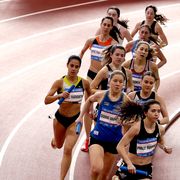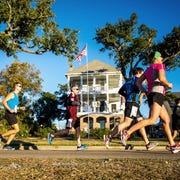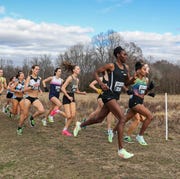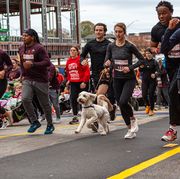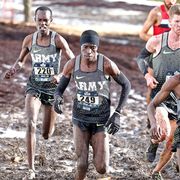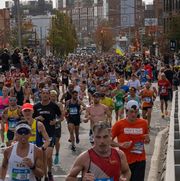Note: This article was originally published in October 2013, soon after Wilson Kipsang set a marathon world record in Berlin. That record was lowered last fall in Berlin to 2:02:57 by Dennis Kimetto.
The fall season for the World Marathon Majors began last weekend with a men’s world record in Berlin by Wilson Kipsang. Meanwhile, the lead women in Berlin not only didn’t threaten the world record, but weren’t close to breaking 2:20.
It may not be worthwhile to commit Kipsang’s 2:03:23 to memory. During the past 10 years, the men have lowered the world mark five times [editor's note: now six]. In contrast, no woman has come close to Paula Radcliffe’s 2:15:25, set April 13, 2003 in London.
More From Runner's World

Radcliffe has said – was she only half serious? – that she fantasizes the record will last until her daughter, Isla Lough, now 6, breaks it.
“Records are meant to be broken, but I am confident we will continue to see Paula's record in the books for decades longer,” says Deena Kastor, who holds the American record of 2:19:36. “Fans of this sport will continue viewing her 2:15 performance as iconic, heroic and a stunning sprint of 26.2 miles.”
The mark by Radcliffe, who has the event’s top three times and four of its top seven, is an outlier. The next fastest woman marathoner in history is Russia’s Liliya Shobukhova at 2:18:20, which she ran two years ago in Chicago.
When Radcliffe set her record, the men’s world best was 2:05:38, by Khalid Khannouchi. Last year, 16 men ran faster than Khannouchi’s old record, while the fastest woman of the year, Mary Keitany, ran 2:18:37, more than three minutes slower than Radcliffe’s record. Why has men’s elite marathoning progressed in such stunning fashion in the last decade without similar momentum on the women’s side?
Jack Daniels, a long-time and respected exercise physiologist/coach, is not surprised that Radcliffe’s mark has not been threatened.
Daniels, now the men’s and women’s cross country coach at Wells College, an NCAA Division III school in Aurora, New York, has devised a system he named VDOT to measure a runner’s ability and to structure training. Radcliffe’s marathon mark has the highest VDOT value, tied with Wang Junxia of China’s 20-year-old mark for 3000 meters (8:06.11), among women’s middle-distance and distance records.
“Those are the top two female world records, just a little above the 5K and 10K, according to the VDOT tables,” says Daniels. “The men’s marathon is tenth on the men’s list and the women’s marathon is tops among women. When you compare men and women, it kind of interesting that a woman has had the best distance performance in a marathon and the men haven’t. The men have a better world record in half, 5K, 10K, 20K, the 1500, the 3,000, mile and 800. All those are better than the marathon. And plenty of men have run plenty of marathons.”
So what does that say about Radcliffe’s 2:15?
Daniels laughs: “It says she ran an awfully fast time, that’s all I can say. It’s unbelievable. I guess it’s believable, but it’s incredibly fast.”
Clearly Radcliffe, who turns 40 in December and is currently not running due to foot problems, was a special competitor. She was good when she was young. She won the 1992 world junior cross country title, beating Wang at the race in Boston. Her VO2 max, a measure of her oxygen-carrying capacity, practically didn’t change from that time. Her running economy, however, improved impressively despite an unorthodox running style that featured a bobbing, snapping head that almost made it look like she was dozing off in the middle of a race.
“She doesn’t look like the most beautiful runner,” Daniels says. “That hardly matters. What she’s doing is taking advantage of what she has. I don’t know what her economy values are. I know in all the elite runners I’ve tested over the years economy varies tremendously.
“You can’t just look at somebody and say this person is more economical than that person," Daniels says. "We did a study on that one time. We measured a bunch of runners’ economy and filmed them front, side and back. We asked coaches and biomechanists to rank them as to who was the most economical. They couldn’t come close.”
So who knows what a future record holder in the women’s marathon will look like. She’ll have to be fast at other distances – Radcliffe ran 30:01.09 for 10K and 14:29.11 for 5K.
“There are very few women in the world that have run that fast,” says Terrence Mahon, who was Kastor’s coach when she set the American record. “So starting from that base, then we see that only a handful of women in history even have a shot at a 2:15 marathon.
“After that we then need to add in a really well-developed training program, great therapy support, nutritional support, etc. Then come race day, you need great weather, pacing and the like," says Mahon.
“Also, given that Paula is a front runner, the lack of competition in her race may have been an asset, as it allowed her to purely focus on the race against the clock," says Mahon. "All of these factors coming together on that one day are what lead to such a ‘Beamonesque’ performance.
“If we look at the other women that have the necessary 10K speed – such as [Tirunesh] Dibaba, [Meseret] Defar, [Meselech] Melkamu and others – we can see that most of these women aren't time-trialers by nature," says Mahon. "They prefer to sit and kick. Although a great asset for the track, it doesn't always lead to phenomenal marathon record performances. So until we see another woman with that front-running tenacity and who also possesses the ability to handle the incredible training load required to get that marathon-fit, then I see the record lasting quite a while longer.”
The women chasing Radcliffe’s standards almost appear to be running slower in recent years. Since Japan’s Naoko Takahashi broke the 2:20 barrier at Berlin in 2001, 16 other runners have broken 2:20 a total of 22 times. In the last six years, there have been only 10 sub-2:20s, six recorded in 2012.
There are a variety of theories as to why. Is it that women can now win major marathons without having to break 2:20? Is it that many of the big races now have women-only starts so men aren’t around to “pace” them? Is it cyclical?
“I think the depth is there on the women's side,” Mahon says. “There are a lot more athletes running in the 2:21-22 range than before. However, I also see that there are more marathons with decent prize money, so that splits up the numbers a bit, as getting paid is a top priority over running fast – there is always a big risk of blowing up when chasing fast times.”
Daniels doesn’t have a theory to explain the lack of recent sub-2:20s.
“Maybe it all goes up and down,” he says. “Now that there have been fewer faster times, more will give it a try. But when times get better, fewer want to bother with marathons.”
Ten years on, Radcliffe’s time is more special than ever. A fan might want to commit it to memory.



